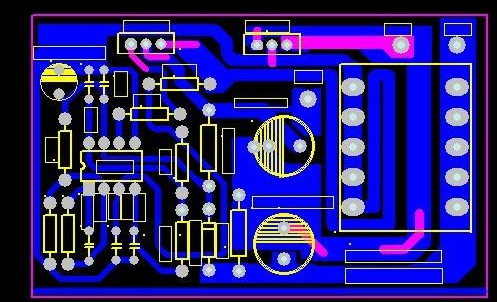Before explaining the PCB wiring before completing the inspection work, I will first introduce you to three special wiring techniques for PCBs.
The PCB layout line will be explained from three aspects: right-angled line, differential wiring, and serpentine line:
1. Right-angle line (three aspects) The influence of the right-angle line on the signal is mainly reflected in three aspects: First, the angle can be equivalent to the capacitive load on the transmission line, which slows down the rise time, and the second is that the impedance discontinuity will cause Signal reflection, the third is the right-angle tip generated by EMI, which exceeds the 10GHz RF design field,
These small right angles may become the focus of high-speed problems.
2. Differential wiring ("equal length, equidistant, reference plane") What is a differential signal (differential signal)? In popular terminology, the driver sends two equivalent inverted signals, and the receiver determines the logic state "0" or "1" by comparing the difference between the two voltages. And the pair of wires carrying differential signals are called differential wires.

Compared with ordinary single-ended signal wiring, the most obvious advantage of differential signal lies in the following three aspects:
1) The anti-interference ability is strong, because the coupling between the two differential lines is very good. When there is noise interference from the outside, they are coupled to the two lines almost at the same time, and the receiving end only pays attention to the difference between the two signals, so the external common Mode noise can be completely canceled.
2) It can effectively suppress EMI. For the same reason, due to the polarity of the two signals, their external radiated electromagnetic fields can cancel each other. The closer the coupling, the less electromagnetic energy released to the outside world.
3) Precise timing positioning, because the change of the differential signal switch is located at the intersection of the two signals, unlike ordinary single-ended signals that rely on the high and low threshold voltage judgments, so through this process, the temperature effect is small and can be reduced Timing error is also more suitable for low-amplitude signal circuits.
The current popular LVDS (Low Voltage Differential Signaling) refers to this small amplitude differential signal technology.
3. Snake line (adjust delay) Snake line is a wiring method commonly used in layout. Its main purpose is to adjust the delay to meet the system timing design requirements. The most critical of the two parameters are the parallel coupling length (Lp) and the coupling distance (S). Obviously, when the signal is transmitted on the serpentine line, in the differential mode, there will be coupling between the parallel line segments, and the smaller S is, The greater the Lp, the greater the degree of coupling. It may lead to a reduction in transmission delay and greatly reduce the signal quality caused by crosstalk. The mechanism can refer to the analysis of common mode and differential mode crosstalk.
The following are some suggestions for layout engineers to deal with serpentine lines: 1) Maximize the distance (S) of the parallel segment, at least greater than 3h, where h refers to the distance from the signal line to the reference plane.
It is popular to bypass the Big Bend line. As long as s is large enough, the coupling effect between each other can be almost completely avoided.
2) Reduce the coupling length LP. When the LP delay is twice as close to or exceeds the signal rise time, the resulting crosstalk will reach saturation.
3) The signal transmission delay caused by the serpentine line of the strip line (strip line) or buried microstrip line (embedded microstrip) is less than the signal transmission delay of the microstrip line (microstrip).
In theory, due to differential mode crosstalk, the stripline will not affect the transmission rate.
4) The high-speed and strict timing requirements of the signal line, try not to take the serpentine line, especially on the small-scale winding line.
5) It is often possible to use serpentine wiring at any angle, which can effectively reduce the coupling between each other.
6) High-speed PCB design, the serpentine line has no so-called filtering or anti-interference ability, which will only reduce the signal quality, so it can only be used for time series matching and has no other purpose.
7) Sometimes the winding method of spiral wire can be considered, and the simulation display effect is better than that of ordinary serpentine wire. After PCB routing, the wiring is completed? Obviously, no! It is also very necessary after the PCB wiring inspection work, so how to check the PCB design and wiring, but also to learn more about other related knowledge.